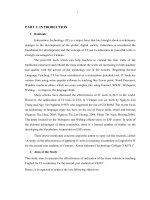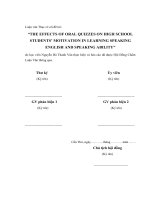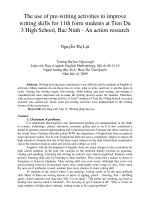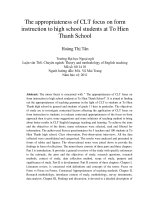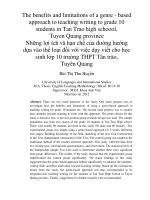Raising the awareness of protecting the natural environment when teaching english for high school students
Bạn đang xem bản rút gọn của tài liệu. Xem và tải ngay bản đầy đủ của tài liệu tại đây (1.95 MB, 18 trang )
1. INTRODUCTION
1.1. Reasons for the study
It can be seen that the natural environment is the place in which all
organisms live, and the human race is only one small species. However, human
beings have great influence on the rest of the world. They are changing the
natural environment by many ways, such as building cities and villages where
forests once stood, or cutting down trees in the forests, or adding pollutants to
the air, etc. It can be said that humans are changing the environment in all
aspects through their actions and by their habits. This has resulted in many
serious consequences. Many kinds of animals and plants are killed, and even
many of which are in danger of becoming extinct. The natural habitat is badly
destroyed and seriously contaminated. Thus, it is vital to protect the Earth, the
home of all organisms, from human beings’ harmful activities. It is time humans
did something on the problem of environmental pollution, which will help
maintain the ecosystem.
Despite the fact that humans get lots of benefits from the nature, they still
devastate it day by day and step by step. They are throwing rubbish wherever
they are. They are cutting down many kinds of trees for wood and timber. They
are illegally hunting animals for fur, hide, meat and other products. Many
factories are discharging toxic smoke and waste into the environment, etc. All
these actions are seriously polluting the environment, including the air, water
and soil. As a result, the problem of environmental pollution are getting worse
and worse. However, there have still been many people, especilly the young,
who are not aware of the importance of the natural environment to humans’ life
and to other living things’ survival. They are also not aware of the situation of
the environmental contamination, which is becoming an alarming problem all
over the world. Moreover, they do not realise that it is time for humans to stop
making the problem worse and worse so that they will have good natural
conditions to live and to flourish.
All reasons mentioned above led me to the following study “Raising the
awareness of protecting the natural environment when teaching English for
high school students”. I hope that my study will help make a change in
students’ attitude, awreness and actions, which may make them become activists
who voluntarily do many good things for the nature.
1. 2. Purposes of the study
As mentioned above, the Earth is the home of all organisms. Therefore,
protecting the earth, protecting the nature mean protecting humans themselves
and their “friendly neighbours”. It is obvious that humans cannot exist by
themselves on earth. They need animals and plants for food, and other living
things for their other purposes in their daily lives. Hence, it is essential for
humans to stop polluting the nature and to make efforts to protect it. This will
1
help human beings and other organisms co-exist happily on the green planet, the
Earth.
Doing this research, I would like to help my students realise that the
nature play a vital role in humans’ life. However, humans have been polluting it
and destroying it. Thus, the environmental pollution is becoming an
international problem which reqiuires all countries to work together to find out
possible solutions. I would also like to help my students see and understand the
situation of the problem. They can see many types of pollution everywhere, at
their home, in their school, on the ways and streets, in their neighbourhood, on
the beach, on the farm, in the camping sites, in places of interests, etc. Thus,
they have to do something to help clean up all of these places so that they will
have somewhere clean, fresh, and safe to live. Being aware of the importance of
protecting the environment will lead students to useful actions. Besides, I would
really like to help them build good daily habits related to the environmental
protection, such as cleaning up their house, classroom everyday, or putting
rubbish into the dust bin, growing as many trees and flowers around their houses
and in their neighbourhood as possible. Furthermore, some of my students may
love the topic of the nature. They will try to become activists, or volunteers who
voluntarily do very useful things for the nature, to protect it from the harmful
activities of the humans and to make the nature environment a ideal place to
live.
1. 3. The scope of the study
In this study, only some aspects related to the main theme can be
mentioned, such as the definition and types of natural environment, benefits
from the nature, the definition of environmental pollution, causes and effects of
pollution, and some solutions to the problem. Hoping that readers will have a
general view on the problem mentioned, then get themselves involved in many
useful to protect the nature.
1. 4. The methods of the study
To fulfil this study, I apply many methods at the same time to make full
use of each. First, I used 3 textbooks of English 10, 11, 12 as my first idea. I
used some Units and some parts of one unit mentioning about the natural
environment to plan for my study. For example, unit 10 (Conservation) in
English 10; unit 10 (Nature in danger) in English 11 or unit 10 (Endangered
species), in English 12. Second, I searched many information and images,
pictures related to the scop of the study on the internet. After that, I had to read
carefully then choose which was the best for my study. Third, I asked my
colleages who teach English for some advices of good writing as well as those
who teach geography and biology for some knowledge related. And last, I use
my lesson of language as a lesson of protecting the environment to raise my
students’ awareness of the problem.
2
2. MAIN CONTENT
2.1. THE FOUNDATION OF THE STUDY
a. What is the natural environment?
According to some pretigous dictionaries, the natural environment is
defined as below:
The natural environment encompasses all living and non-living things
occurring naturally on Earth or some region thereof. It is an environment that
encompasses the interaction of all living species. Climate, weather, and natural
resources that affect human survival and economic activity. The concept of
the natural environment can be distinguished by components:
•
•
Complete ecological units that function as natural systems without
massive
civilized
human
intervention,
including
all
vegetation,microorganisms, soil, rocks, atmosphere,
and natural
phenomena that occur within their boundaries and their nature
Universal natural resources and physical phenomena that lack clear-cut
boundaries, such as air, water, and climate, as well as energy,
radiation, electric charge, and magnetism, not originating from civilized
human activity
Natural environment means all living and non-living things that are
natuarlly on Earth.
In a narrow sense, it is an environment that is not influenced by people.
Natural environment is often used as a synonym for habitat. For instance, when
we say that the natural environment of giraffes is the savanna.
The environment is something you are very familiar with. It is everything
that makes up our surroundings and affects our ability to live on the earth - the
air we breathe, the water that covers most of the earth's surface, the plants and
animals around us, and much more.
The sum total of all surroundings of a living organism, including natural
forces and other living things, which provide conditions for development and
growth as well as of danger and damage.
It is clearly that the natural environment is the place where all organisms
should co-exist for their development and grow.
b. Types of the environment
The five main types of environments, or biomes, in the world are the
aquatic, forest, desert, grassland and tundra biomes. Each of these can be found
in many areas around the world and contribute to the world's ecosystem.
Aquatic environments are found all over the world. Roughly 75 percent of
the Earth is covered by water, and all of this water is part of an aquatic
environment. The aquatic biome is further divided into saltwater oceans and
freshwater environments, such as rivers and lakes.
3
Forest biomes are characterized by large trees and vegetation. They can be
found in cold and warm temperatures around the world. These environments are
important to the Earth because they release oxygen into the atmosphere and
capture excess carbon dioxide.
4
5
Deserts are any type of environment that receives less than 10 inches of
precipitation each year. They can be very hot and sandy or very cold and icy.
Grasslands are large biomes characterized by huge open areas that receive
between 10 and 30 inches of precipitation per year. These areas are covered
mostly by grass and have few trees and other types of vegetation. They are home
to a wide variety of animals that use the grass for food
6
Tundra is the coldest biome of all of the different environments. Tundras
have long, cold winters and very short summers.
2.2. The state of pollution
a. The environmental pollution
Environmental pollution has existed for centuries but only started to be
significant
following
the
industrial
revolution
in
the
th
19 century. Pollution occurs when the natural environment cannot destroy an
element without creating harm or damage to itself. The elements involved are
not produced by nature, and the destroying process can vary from a few days to
thousands of years (that is, for instance, the case for radioactive pollutants). In
other words, pollution takes place when nature does not know how to
decompose an element that has been brought to it in an unnatural way.
Pollution must be taken seriously, as it has a negative effect on natural
elements that are an absolute need for life to exist on earth, such as water and
air. Indeed, without it, or if they were present on different quantities, animals –
including humans – and plants could not survive. Environmental pollution is an
incurable disease. It can only be prevented.
Environmental pollution consists of five basic types of pollution, namely,
air, water, soil, noise and light.
Air pollution is by far the most harmful form of pollution in our
environment. Air pollution is caused by the injurious smoke emitted by cars,
buses, trucks, trains, and factories, namely sulphur dioxide, carbon monoxide
and nitrogen oxides. Even smoke from burning leaves and cigarettes are harmful
7
to the environment causing a lot of damage to man and the atmosphere.
Evidence of increasing air pollution is seen in lung cancer, asthma, allergies, and
various breathing problems along with severe and irreparable damage to flora
and fauna. Even the most natural phenomenon of migratory birds has been
hampered, with severe air pollution preventing them from reaching their
seasonal metropolitan destinations of centuries.
Chlorofluorocarbons (CFC), released from refrigerators, air-conditioners,
deodorants and insect repellents cause severe damage to the Earth’s
environment. This gas has slowly damaged the atmosphere and depleted the
ozone layer leading to global warming.
Water pollution caused industrial waste products released into lakes,
rivers, and other water bodies, has made marine life no longer hospitable.
Humans pollute water with large scale disposal of garbage, flowers, ashes and
other household waste. In many rural areas one can still find people bathing and
cooking in the same water, making it incredibly filthy. Acid rain further adds to
water pollution in the water. In addition to these, thermal pollution and the
depletion of dissolved oxygen aggravate the already worsened condition of the
water bodies. Water pollution can also indirectly occur as an offshoot of soil
pollution – through surface runoff and leaching to groundwater.
8
Noise pollution, soil pollution and light pollution too are the damaging the
environment at an alarming rate. Noise pollution include aircraft noise, noise of
cars, buses, and trucks, vehicle horns, loudspeakers, and industry noise, as well
as high-intensity sonar effects which are extremely harmful for the environment.
Soil pollution, which can also be called soil contamination, is a result
of acid rain, polluted water, fertilizers etc., which leads to bad crops. Soil
contamination occurs when chemicals are released by spill or underground
storage tank leakage which releases heavy contaminants into the soil. These may
include hydrocarbons, heavy metals, MTBE, herbicides, pesticides and
chlorinated hydrocarbons.
9
Light Pollution includes light trespass, over-illumination and astronomical
interference.
b. Causes of environmental pollution and the effects
Let us first take a look at the causes of environmental pollution:
- Industries: Industries have been polluting our environment especially since
the beginning of the industrial revolution, as mentioned above, notably due to
the increasing use of fossil fuels. In the 19th century and for a significant part of
the 20th century, coal has been used to make machines work faster, replacing
human force. Though pollution by industries mainly causes air pollution, soil
and water contamination can also occur. This is particularly the case for powergenerating industries, such as plants producing electricity (May they be a dam, a
nuclear reactor or some other type of plant).
10
Also, the transportation of this energy can be harmful to the environment.
We can take an example of the transportation of petrol through pipelines; if there
is a leak in the pipeline, soil will automatically be polluted. At the same time, if
the tanker transporting the petrol from its production plant to the place where it
will be consumed leaks or sinks, the water will get contaminated.
- Transportation: Ever since men abandoned animal power to travel, pollution
of the environment has become worse and worse. Its levels have only been
increasing until now. Similarly to industries, pollution caused by transport can
mainly be attributed to fossil fuels. Indeed, humans went from horse carriages to
cars, trains (which, before electricity, used to be propelled by coal), and
airplanes. As the traffic is increasing every day, pollution follows that evolution.
- Agricultural Activities: Agriculture is mainly responsible for the
contamination of water and soil. This is caused by the increase in the use of
pesticides, as well as by the intensive character of its production. Almost all
pesticides are made from chemical substances and are meant to keep diseases
and threatening animals away from the crops. However, by keeping these forms
of life away, harm is almost always made to the surrounding environment as
well. Furthermore, as agriculture gets more and more intensive to feed
the increasing world population, more environments and ecosystems are
destroyed to make space for the crops. Some of them, like rapeseed –used to
make oil – demand a lot of space for a relatively small output.
- Trading Activities: Trading activities including the production and exchange
of goods and services. Concerning goods, pollution can be caused by packaging
(which often involves the use of plastic, which is made from fossil fuels) or
transport, mainly.
- Residences: Finally, residential areas provide their fair share of pollution as
well. First, to be able to build homes, natural environment has to be destroyed in
one way or another. Wildlife and plants are driven away and replaced by human
constructions. As it requires the work of industries, construction itself is also a
source of contamination of the environment. Then, when people settle in, they
will produce waste every day, including a part that cannot be processed by the
environment without harm yet.
The state of being polluted will affect on the followings
- Effects on Humans: The effects of environmental pollution on humans are
mainly physical, but can also turn into neuro-affections in the long term. The
best-known troubles to us are respiratory, in the form of allergies, asthma,
irritation of the eyes and nasal passages, or other forms of respiratory infections.
Notably, these well spread affections can be observed when air pollution is high
11
in cities, when the weather gets hot, for instance. On top of that, environmental
pollution has been proven to be a major factor in the development of cancer.
This can happen for example when we eat reminiscences of pollutants used in
the production of processed foods, or pesticides from the crops. Other, rarer,
diseases include hepatitis, typhoid affections, diarrhoea and hormonal
disruptions.
- Effects on Animals: Environmental pollution mainly affects animals by
causing harm to their living environment, making it toxic for them to live
in. Acid rains can change the composition of rivers and seas, making them toxic
for fishes, an important quantity of ozone in the lower parts of the atmosphere
can cause lung problems to all animals. Nitrogen and phosphates in water will
cause overgrowth of toxic algae, preventing other forms of life to follow their
normal course. Eventually, soil pollution will cause harm and sometimes even
the destruction of microorganisms, which can have the dramatic effect of killing
the first layers of the primary food chain.
- Effects on Plants: As for animals, plants, and especially trees, can be
destroyed by acid rains (and this will also have a negative effect on animals as
well, as their natural environment will be modified), ozone in the lower
atmosphere block the plant respiration, and harmful pollutants can be absorbed
from the water or soil.
- Effects on the Ecosystem: In short, environmental pollution, almost
exclusively created by human activities, has a negative effect on the ecosystem,
destroying crucial layers of it and causing an even more negative effect on the
upper layers.
c. Pollution in Vietnam
As mentioned above, pollution is not the problem within the boundaries of
a certain country. It is an international problem which requires all nations to join
hands to solve. Many “symptoms” of the desease called “pollution” have
seriously affected humans’ life, such as ice-melting, global warming, greenhouse
effect, which result in many natural disasters like floods, drough, stunami,
earthquakes, hurricane, etc,.
There have been all types of pollution in Vietnam. The air is being
destroyed by smokes emitted from factories, exshaust from vehicles like cars,
trains, buses including the dust from the roads which are downgraded by many
reasons. The water is polluted by industrial waste which can kill many kinds of
aquatic animals. Take the incident of Formosa as an example. This company
illegally poured their factories waste into the sea in Vung Ang Habour, in Ha
Tinh province, which caused the death of million tons of sea animals along the 4
12
coastal provinces in the centre of Vietnam, namely Ha Tinh, Quang Binh, Quang
Tri, Thua Thien – Hue.
(A villager shows dead sea fish he collected on a beach in Phu Loc district, after
the incident of Formosa)
Furthermore, many beaches in Vietnam have been full of plastic bags, tin,
glasses, cigarette butts, etc,. which are left behind by the visitors. This makes an
ugly image of the beach, one of the places of interest in Vietnam. Besides,
farmers use a lot of pesticides, herbicides for their crops, which leads to the
contamination of both soil and water.
13
(chemical fertilizer isues)
2.3. Raising the awareness of students on protecting the environment while
teaching some lessons in the textbooks.
It can be seen that the theme “nature” or “natural environment” is
mentioned in 3 textbooks English 10, English 11 and English 12. Hence, it is
essential to do something to raise my students’ awareness on protecting the
environment through my lessons.
a. The awareness of protecting the seas and oecans.
The oceans, seas, gulfs and bays cover 75 percent of the earth’s surface,
excluding the rivers and lakes. These environment supply a great source of sea
animals which become humans’ food and other valuable products. Rivers and
lakes provide humans with water for domestic uses, farming and industries.
However, the oceans, seas, rivers and lakes are now polluted badly by thousand
tons of rubbish or toxic chemicals thrown away by humans’ activities. Thus,
before teaching unit 9: The Undersea World in English 10, I will ask my
students to fulfil a “project” related to the seas or oceans as below
First, I divide the whole class into 4 groups, then choose one group leader
for each. All group memmbers have to work together (that means I have to
explain to my students how to work in groups and what they need while working
in team and how to ues the technique of brainstorming. The skill of working in
groups and the technique of brainstorming were mentioned in my own studies
which were rated level C some years ago). They also have to use the help of the
internet to search what they want.
Then I ask each group to find out as much information related to the
following aspects as possible.
14
- The benefits that humans get from the seas, oceans
- How pulluted they are now
- Causes of the state of pollution and effects
- Some suggested solutions to protect the oceans and seas,
Students have to try their best to read, to search the information related to their
question
After limited time of some days working in groups, students hand in their
group work and I have to evaluate, remark and correct if necessary. I may use
this useful information in the warm-up stage in my lessons within the unit to
activate my students.
To complete the task, my students have to read a lot, search many things
and choose the best information for their answer. This process helps them
understand the state of pollution, see the need of saving the oceans and seas.
This may also help them know how to respect the oceans and leads them to good
actions when spending their holiday in the beach, for instance they may not
leave rubbish in the beach during their stay. Or they may want to become a
volunteer in the movement of “cleaning up the seas”.
b. The awareness of protecting the natural habitat.
The natural habitat is the place where animals and plants live naturally
without humans’interference. However, it is damaged badly by the humans’
actions such as cutting down the forests for wood or for farming land, illegal
hunting rare animals for fur, hide, meat and other products, and many harmful
activities to the nature. Therefore, many kinds of rare animals and plants have
become extinct or endangered.
To raise the awareness of protecting the natural habitat I suggest one way
as below.
Still making full use of group work, I ask my students to work in groups
of 4 to find information related to one of the following questions
- The area of forests in Vietnam
- The benefits that humans gets from the forests
- The damage to the forests, animals and plants
- The effects of cutting down the forests
- Some possible solutions to protect the forests, animals and plants
- List national parks in Vietnam and their advantages
15
The picture above brings us an overall view on the benefits of the
forests. The forsets including trees, plants and vegetation are considered as the
two lungs of a living body, the earth. They provide all living things on earth with
great source of oxygen, they help clean the air, but “the lungs” are destroyed. As
a result, the body will get sickness and serious deseases.
The process of searching for the information helps students well
understand the importance of the forests including animals and plants. This may
harbour the thoughts that they must take responsibility for the protection.
2.4. The effects of my study
As mentioned in the part 2.3, the process of searching information on
the Internet, reading and watching images provides my students with plenty of
useful information. They know more about the state of pollution and the reasons
for this state, then they try to find out how to solve the probem. And the most
important thing is that they change their attitude and action to the environment.
They learn how to respect the nature and know how to act with the nature so that
they will have an ideal place to live. This change results in daily activities. They
will not do anything harmful to their neighbourhoods and their surroundings.
They will voluntarily make their classrooms, school, houses and
neighbourhoods cleaner and fresher.
For the school, if each student has good action to the environment, the
whole school will become cleaner and cleaner.
3. Conclusion and suggestions
Conclusion
In general, environmental pollution is a complicated problem which
requires all nations to join hands to deal with. Because many things benefiting
16
humans may become a factor that pollutes or damages the environment. Once
the nature is damaged, humans may be afftected.
The young is the future generations of each country. They have to
become good people having much scientific knowledge and having good
actions. When they are at school, it is important to help them attain knowledge,
build skills and to raise their awareness of some crucial problems including the
need of protecting the environment.
It is time humans stopped destroying the earth, the natural environment
by their daily activities. Raising humans’ awareness of protecting the
environment is now essential to save the earth and humans themselves.
THE HEADMASTER’S IDEAS
Thanh Hoa, 16 May 2016
I ensure that this study be written by
myself, not be copied from anybody
else
Doãn Thị Bảo Chung
17
1.
2.
3.
4.
-
References
English 10, (the fifth edition), Vietnam Educational Publisher.
English 11, (the forth edition), Vietnam Educational Publisher.
English 12, (the third edition), Vietnam Educational Publisher.
Some websites:
www.business dictionay.com
www.merriam-webster.com
www.oxforddictionary.com
www.uccee.org/environmental_pollution
www.ask.com
www.conserve-energy-future.com/causes-effects-solutions
18
